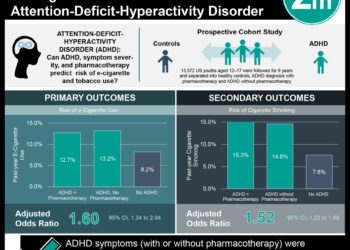Adolescent e-cigarette use follows several distinct trajectories
1. Surveys of 1,800 students every 6 months throughout high school showed steadily increasing rates of e-cigarette use, with 17% reporting e-cigarette use in the last 30 days by 12th grade.
2. Four classes of e-cigarette users with variable risk factors were modeled, including dual users of combustible cigarettes and e-cigarettes, users of e-cigarettes alone who started early in high school and used steadily, and e-cigarette users who took up e-cigarettes more rapidly and later.
Evidence Rating Level: 2 (Good)
Study Rundown: E-cigarettes have grown dramatically in popularity among adolescents in recent years and are their use is a risk factor for smoking combustible cigarettes. This study aimed to create a predictive model to identify which adolescents are at highest risk of progression to persistent e-cigarette use and to cigarette smoking. Students at 4 public high schools in suburban Philadelphia were asked to complete surveys every 6 months for 36 months beginning in 9th grade and ending in 12th grade. 3 distinct classes of adolescent e-cigarette users were identified through modeling of the survey data: those who rapidly began to use e-cigarettes, those who steadily began using e-cigarettes at a younger age, and dual e-cigarette and cigarette users. Adolescents in the last class had the most and most severe risk factors related to their smoking, including peer cigarette smoking and e-cigarette use, household smoking, personal marijuana or alcohol use, and depressive symptoms. Adolescents who began using e-cigarettes early but did not progress to use of cigarettes reported a higher number of peers who used e-cigarettes and more difficulty accessing cigarettes. The group who began using e-cigarettes later in high school generally lacked smoking risk factors, suggesting that a large portion of eventual users may be hard to identify for targeted prevention. This study thus underscores the importance of broad screening and prevention efforts beginning in mid-adolescence. A major limitation of this study is that data were drawn from surveys and are therefore subject to reporting biases. Demographic and other risk factors were also only modeled at baseline, though many risk factors, particularly peer cigarette and e-cigarette use, likely changed over time.
Click to read the study in Pediatrics
Relevant Reading: E-cigarette and vaping product use-associated lung injury in the pediatric population: A critical review of the current literature
In-Depth [prospective cohort]: The study cohort was assembled from adolescents in 9th grade at 4 high schools chosen to reflect national demographics. Adolescents with severe learning disabilities and those without English fluency were excluded. 1,808 participants initially provided complete survey data, with 83% completing the final survey. A sequential processes growth mixture model was used to identify 4 conjoint latent classes of adolescents who use e-cigarettes. Class 1, representing later, rapid e-cigarette uptake, included 230 adolescents. Class 3, representing earlier, steady uptake, included 265. Class 4, representing dual e-cigarette and cigarette use, included 204. Multinomial logistic regression was then used to reflect the likelihood of belonging to each conjoint class based on demographics and other risk factors. Female students were more likely to use e-cigarettes alone, while male sex was a risk factor for dual use.
Image: PD
©2021 2 Minute Medicine, Inc. All rights reserved. No works may be reproduced without expressed written consent from 2 Minute Medicine, Inc. Inquire about licensing here. No article should be construed as medical advice and is not intended as such by the authors or by 2 Minute Medicine, Inc.






